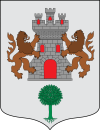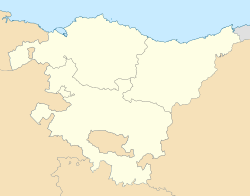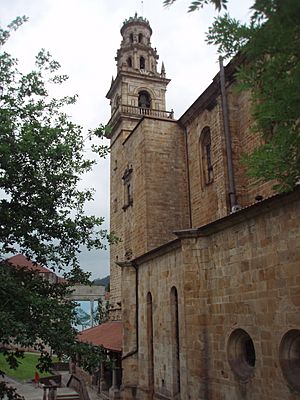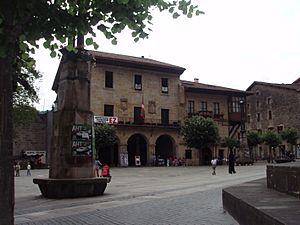Elorrio facts for kids
Quick facts for kids
Elorrio
|
||
|---|---|---|
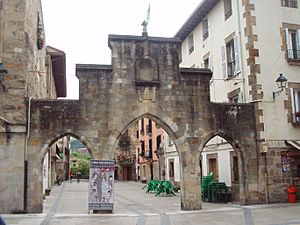
An archway in Elorrio
|
||
|
||
| Nickname(s):
Elorrixo
|
||
| Country | ||
| Autonomous community | ||
| Province | Biscay | |
| Comarca | Durangaldea | |
| Founded | 1356 | |
| Area | ||
| • Total | 37.32 km2 (14.41 sq mi) | |
| Elevation | 185 m (607 ft) | |
| Population
(2018)
|
||
| • Total | 7,336 | |
| • Density | 196.57/km2 (509.11/sq mi) | |
| Demonym(s) | Spanish: elorriano (ana) Basque: elorriotarra |
|
| Time zone | UTC+1 (CET) | |
| • Summer (DST) | UTC+2 (CEST) | |
| Postal code |
48230
|
|
Elorrio is a town and a municipality in the eastern part of the Biscay province. It is located in the Basque Country, in northern Spain. In 2017, about 7,307 people lived there. The town covers an area of 37.20 square kilometers. Elorrio is known by its old medieval title: "Most Loyal and Noble Villa."
Elorrio was founded in 1356 by Don Tello Alfonso of Castile. He was the 20th Lord of Biscay. The town was built near the old church area of Saint Agustín of Etxebarria. This area was historically part of the medieval County of Durango. Today, Elorrio is still part of the Durangaldea region. In 1630, Elorrio officially joined with Saint Agustín of Etxebarria. This area is now a part of Elorrio.
The town's main activity has been the industrial sector. Elorrio is also famous for its many beautiful old buildings. These buildings are so important that the Ministry of Culture has listed the town as a Conjunto histórico, which means a historical site.
Contents
What's in a Name?
In the Basque language, the word elorrio means the red fruit of the common hawthorn tree. The Basque word elorri means "hawthorn." You can even see a hawthorn tree on the town's coat of arms. People sometimes call the town Elorrixo in Basque.
A Look Back in Time
Just outside Elorrio, you can find the Argiñeta tombs. Some of these tombs are from before Christianity, and others are Christian. The oldest Christian tomb dates back to 893. In 1053, the San Agustín de Etxebarria monastery was built. This monastery was later rebuilt and became the beautiful Gothic church you see today.
In 1356, Don Tello, the Lord of Biscay, officially created Elorrio. He did this to build a town that could protect his borders. It helped defend against attacks from the nearby area of Gipuzkoa. In 1468, a big battle happened in Elorrio. It was between two fighting groups in the Basque Country.
After this, the fighting stopped, and Elorrio became richer between the 1500s and 1700s. The town was known for its iron factories. They were especially good at making lances. Because the town grew, many important buildings were constructed. Most of these were built in the 1500s. Today, these buildings are seen as very important historical and architectural sites.
In the 1800s and early 1900s, Elorrio became a popular place for tourists. People came to visit its two famous spas. After the Spanish Civil War, Elorrio became more industrial. Many small family businesses and worker-owned companies started there. In 1964, Elorrio was the first town in Biscay to be called a "Centre of Historical and Artistic Importance." The number of people living in Elorrio grew from 3,500 in 1950 to 8,000 in 1981. Today, it has about 7,000 residents.
Where is Elorrio?
Elorrio is located in the easternmost part of Biscay. It is in the Durangaldea region of northern Spain. It shares borders with several other towns and provinces:
- To the north: Berriz and Zaldibar
- To the northwest: Abadiño
- To the west: Atxondo
- To the east: The province of Gipuzkoa
- To the south: The province of Álava
Mountains like Intxorta (797 meters) and Udalatx (1092 meters) surround the town. The Zumelegi river flows through Elorrio. This river later joins the River Arrazola to form the Ibaizabal river. Elorrio is about 39 km from Bilbao, which is the capital city of the province.
How Many People Live Here?
| Historical population | ||
|---|---|---|
| Year | Pop. | ±% |
| 1900 | 2,776 | — |
| 1910 | 2,854 | +2.8% |
| 1920 | 3,014 | +5.6% |
| 1930 | 3,004 | −0.3% |
| 1940 | 3,077 | +2.4% |
| 1950 | 3,567 | +15.9% |
| 1960 | 4,830 | +35.4% |
| 1970 | 7,334 | +51.8% |
| 1981 | 7,857 | +7.1% |
| 1990 | 7,526 | −4.2% |
| 2000 | 7,166 | −4.8% |
| 2010 | 7,252 | +1.2% |
| 2013 | 7,294 | +0.6% |
The National Institute of Statistics estimated that Elorrio had 7,372 people living there in 2019.
What About the Economy?
Elorrio's economy mostly depends on its factories and industries. However, farming is still important in the area. Most farms raise beef cattle or produce milk. Some also grow pine trees. The most important economic activity is the metal processing industry. Several metal factories are located in Elorrio.
Getting Around Elorrio
The main way to travel to and from Elorrio is by road. The BI-634 road goes through the town. This road connects Elorrio with Durango, the main town of the region. It also connects to Arrasate-Mondragón in the province of Gipuzkoa.
In Durango, you can connect to the AP-8 highway. This highway goes to Bilbao and Donostia-San Sebastián. In Arrasate-Mondragón, you can connect to the AP-1 highway. This highway leads to Eibar and Vitoria-Gasteiz. From Elorrio, two other roads start: the BI-2632 to Bergara and Elgeta, and the BI-3321 to Berriz.
Two bus lines from the Bizkaibus network stop in Elorrio. These are lines A3923 and A3914. You can catch a bus to Bilbao every hour. Buses to Durango and other smaller towns run every 30 minutes.
Famous People from Elorrio
- Aniceto Sagastizabal (born 1940): Known as 'Gasti,' he was a professional player of the Basque sport Cesta Punta, also called Jai Alai. He played from the mid-1950s to the early 1980s in many countries.
- Saint Balendin Berrio-Otxoa (1827-1861): Born in Elorrio, he became a Dominican priest and missionary. He was sent to Asia and became a bishop. He was killed in 1861 and later recognized as a saint by Pope John Paul II in 1988.
- José Antonio Ardanza (born 1941): He was the president of the Basque Autonomous Community from 1985 to 1999. He also led a Basque telecommunications company until he retired in 2011.
- Alejandro Goicoechea (1895-1984): He was an engineer who helped create the Talgo railway vehicle.
- Anne Igartiburu (born 1969): A well-known Spanish TV presenter and actress.
- Victor Maria Bereicua (born 1954): A professional Jai-Alai player who used the name 'Elorrio' to honor his hometown. He is famous for being the Jai-Alai player shown in the opening of the TV show Miami Vice.
See Also
 In Spanish: Elorrio para niños
In Spanish: Elorrio para niños


